Why the Humanoid We Really Need Already Lives in a Galaxy Far, Far Away
Forget C-3PO, Give Me K-2SO Any Day Of The Week
“I’ve got a bad feeling about this… and I’m usually right.” — K-2SO
If you ask a robotics engineer which fictional humanoid robot they’d most like to have in their lab, you’ll hear a predictable chorus: C-3PO for etiquette, R2-D2 for utility, maybe Data from Star Trek for that calm, slightly smug intellect.
All wrong.
The real north star for humanoids isn’t the prissy protocol droid or the whistling trash can. It’s K-2SO — the towering, dry-witted ex-Imperial security droid from Rogue One: A Star Wars Story.
Yes, the one who could hack a door, swat a stormtrooper aside, and still get in a sarcastic one-liner while saving the day.
Because if we’re serious about humanoid robots sharing our spaces, they’ll need what K-2SO had in abundance: reach, reliability, and the kind of personality that makes humans want to keep them around.
Height Isn’t a Bug, It’s a Feature
Most real humanoid robots — from Honda’s classic ASIMO to today’s crop like Digit, Figure, and Tesla’s Optimus — hover around human height, usually between 1.5 and 1.7 meters. That sounds good for fitting into our built environment, but anyone who has ever tried to reach the top shelf of a warehouse rack knows we could use a little extra reach.
K-2SO, at 2.1 meters, has the wingspan of a forklift in a trench coat. He’s tall enough to grab the awkwardly placed box without needing a step stool, yet still humanoid enough to navigate a doorway.
In the real world, we spend billions designing forklifts, scissor lifts, and other industrial aids just to get human workers to the right height. Imagine a humanoid that simply…is the right height.
And unlike many of today’s humanoids, K-2SO’s long arms look strong and stable. Too often, modern robots wobble like toddlers reaching for a cookie jar.
We need more droids built like they’ve spent a few years doing warehouse shifts.
A Personality Worth Keeping Around
The biggest gap between fiction and reality in humanoids isn’t in locomotion — it’s in interaction.
Most humanoids today either have the unsettling vibe of a mannequin with Wi-Fi, or they speak in overly cheery scripted lines that feel less “teammate” and more “corporate intern on the first day of orientation.”
K-2SO’s dry wit and unvarnished honesty made him instantly memorable. When he mutters, “I’ll be there for you. The captain said I had to,” you know exactly where you stand with him.
Humans actually respond well to that kind of candor. A robot that can deliver a sarcastic nudge or lighten a tense moment can be a better partner than one trying too hard to sound like your fitness app.
In warehouses, hospitals, even eldercare, there’s something powerful about a robot that can say, “Careful — that box is heavier than you think,” in a way that sounds like a real colleague, not an error log.
Security as Substance, Not Theater
Humanoid robots will increasingly operate in spaces where both safety and trust are paramount. We want them to be strong enough to move crates, restrain a falling load, maybe even guide someone out of harm’s way — but not so unbounded that they pose risks themselves.
K-2SO was literally designed as a security droid. Even after he was re-programmed, his posture, strength, and built-in restraint made him a reliable ally.
That balance is still missing in our real-world humanoids. Too many are either delicate showpieces, good for staged demos but not field work, or over-engineered for power without the right ethical guardrails.
In coming years, standards bodies like ASTM, ISO, and others will have to define not just mechanical safety limits — speeds, torques, forces — but also what I’d call collaborative authority: when and how a humanoid can intervene physically.
If we get it right, the future warehouse robot won’t be a fragile assistant. It’ll be a capable teammate with the moral restraint of a K-2SO.
The Sarcastic Standard
There’s a serious conversation to be had about robots and personality.
As we embed them in workforces, should they be neutral and faceless to avoid manipulation, or expressive enough to build trust and reduce friction?
One day, standards committees may debate “humor thresholds.”
Yes, that sounds absurd — but so did safety standards for collaborative robot arms two decades ago.
Humor, when done well, is a form of social calibration. It tells us the robot understands context. K-2SO’s deadpan delivery wasn’t just comic relief; it was evidence of situational awareness.
Imagine a humanoid nursebot able to say, “You call this needle big? You should see the ones in the other ward,” just as it senses a patient’s rising anxiety.
That’s not just charm — that’s emotional intelligence.
Of course, we’ll need standards to prevent robots from turning into relentless dad-joke machines. That was sarcasm, or was it??
A Teammate, Not a Tool
Robotics often gets stuck in a “tools versus companions” debate. Are humanoids just multi-purpose tools with legs, or are they collaborators we can trust in complex environments?
K-2SO embodied that second option. He didn’t just carry loads or open doors — he made decisions in context, working alongside people as a true teammate.
And in the movie’s climactic scene, he sacrificed himself to buy time for the human team.
While we don’t expect real-world robots to be heroic martyrs, we do expect them to be reliable collaborators under pressure — from disaster response to supply chain crises.
Humanoids that behave more like reluctant colleagues (with good safety protocols) than like shiny new gadgets will find a smoother path into workplaces.
A Galaxy-Wide Lesson
We like to think of humanoid robotics as a frontier of engineering — better actuators, cheaper sensors, more innovative learning algorithms. But the real challenge isn’t just hardware or software. It’s sociotechnical: how robots fit into the human environment and human psychology.
K-2SO reminds us that height, dexterity, and raw processing power are not enough.
A humanoid needs to feel trustworthy, competent, and even a bit relatable.
It needs to meet us halfway — not just by walking on two legs, but by behaving in ways that fit the messy social spaces it’s built to share with us.
TL;DR
The humanoids of the near future won’t be judged just by their actuator torque or AI model size.
They’ll be judged by their collaborative presence: how they show up as partners in our workplaces and communities.
In a galaxy not so far away, K-2SO set the bar:
Tall enough to reach the top shelf, witty enough to be a teammate, and dependable enough to hold the line — and the door — when it really mattered.
If today’s robotics leaders are looking for a role model for tomorrow’s humanoids, they could do worse than take a few notes from a sardonic droid who stole every scene he was in.
Maybe the real lesson is this: building humanoid robots is as much about anthropology and comedy as it is about actuators and code.
Robot News Of The Week
Globant invests in InOrbit Series A to advance robot orchestration
InOrbit Inc., a Mountain View–based provider of AI-powered robot orchestration software, has raised a Series A round co-led by Globant and L’ATTITUDE Ventures. The funding will accelerate platform development and expand its reach in manufacturing, logistics, retail, and hospitality.
Enterprises are embracing automation amid labor shortages and supply chain risks, but adoption is slowed by a fragmented robotics market and siloed infrastructure. InOrbit’s RobOps platform, founded in 2017, acts as a “central nervous system” for robots, coordinating fleets of machines, human workers, and fixed equipment. It integrates with existing enterprise systems like WMS and ERP, rather than replacing them, and enables adaptive, AI-driven responses in real-world operations. Customers include Colgate-Palmolive and Genentech.
CEO Florian Pestoni said the investment validates InOrbit’s vision of “optimizing everything that moves” and highlighted its role at the intersection of agentic AI and physical automation. InOrbit’s software is currently deployed across four continents, and Pestoni will speak at RoboBusiness 2025 on scaling robots “from five to five million.”
Globant will continue offering InOrbit’s platform via its Robotics Studio and enhance it with its Enterprise AI tools, aiming to make robot orchestration a foundational layer of digital transformation.
Serve Robotics brings autonomous food deliveries to Chicago with Uber Eats
Serve Robotics has launched its autonomous sidewalk delivery service in the Chicago metro area, its first move into the Midwest. The rollout builds on the company’s partnership with Uber Eats, which already operates in Los Angeles, Miami, Dallas-Fort Worth, and Atlanta.
Starting in late September 2025, Serve’s AI-powered robots are delivering food from over 100 restaurants to households across 14 Chicago neighborhoods, including Lakeview, Lincoln Park, Logan Square, and Uptown.
“Chicago is known for its food and big personality, and we’re thrilled to add our robots into the mix,” said Ali Kashani, Serve’s co-founder and CEO. Uber Eats’ Megan Jensen added that expanding autonomous delivery improves convenience and reliability for customers.
The launch, along with Serve’s recent acquisition of Vayu Robotics, supports the company’s goal to deploy 2,000 delivery robots nationwide by the end of 2025.
DoorDash unveils Dot, its autonomous robot built to deliver your food
DoorDash has introduced Dot, a small, in-house–built autonomous delivery vehicle capable of driving on roads, bike lanes, and sidewalks at speeds up to 20 mph. Bright red with LED “eyes” and a swinging “mouth” that reveals storage for up to six pizza boxes or 30 pounds of food, Dot is designed to be approachable — though some might find it slightly unsettling.
Currently being tested in Phoenix, Dot is expected to serve the metro area’s 1.6 million residents by the end of 2025. DoorDash sees Dot as a purpose-built alternative to full-size AVs, aiming to tackle the “first and last ten feet” of delivery while reducing traffic and improving efficiency.
Dot uses eight cameras, four radar, and three lidar sensors, powered by AI for real-time navigation. It has a swappable battery, an interior camera for safety, and can pull over and wait if it encounters trouble, with human field operators dispatched when needed.
DoorDash has invested seven years in developing Dot, including AV-related acquisitions and hires. While the company promises human couriers will still handle most orders, Dot represents a bold step in the race to bring autonomous delivery to scale — and may face public skepticism, regulatory scrutiny, and even vandalism along the way.
Robot Research Of The Week
Cybersecurity experts at Alias Robotics have uncovered serious vulnerabilities in the Unitree G1 humanoid robot, which is already used in labs and some police departments. Their audit found that the robot’s Bluetooth Low Energy (BLE) Wi-Fi setup relies on a single, hardcoded encryption key — so weak that encrypting the word “unitree” could unlock full system control.
The team also discovered that the G1 sends data to servers in China every five minutes without user consent and could be repurposed for offensive cyberattacks. Because all units share the same static encryption for internal files, hacking one robot could compromise all others.
The study, published on arXiv, highlights urgent risks as humanoids proliferate in homes, businesses, and critical infrastructure. Researchers warn that securing such robots will require adaptive AI-driven cybersecurity frameworks to address the unique threats at the intersection of physical and digital systems.
Despite being notified, Unitree reportedly stopped responding, prompting the researchers to disclose their findings publicly.
Robot Workforce Story Of The Week
Nebraska Engineering launches state’s first robotics major
The University of Nebraska–Lincoln (UNL) has introduced a Bachelor of Science in Robotics Engineering, the first program of its kind in the state. Backed by a $25 million Heartland Robotics Cluster grant, the major unites faculty and coursework from mechanical, electrical, computing, and agricultural engineering to prepare students for a rapidly evolving robotics industry.
“This program positions Nebraska at the forefront of robotics education in the Midwest,” said Lance Pérez, dean of the College of Engineering. Students begin hands-on work in their first semester with courses like ROBO 100 and progress through a five-course core, choosing specializations in robot design, software, or sensors and signals.
Student interest has been strong. Aleksandra Stansbury, a sophomore who switched from computer engineering, and Ian Gouldie, focused on prosthetic robotics, cited the program’s practical, interdisciplinary approach. Enrollment reached 30 students in its first official cohort this fall.
Associate Dean Carl Nelson said the program aims to produce graduates who can innovate beyond off-the-shelf systems, supporting both local industry and new startups. “When companies see our graduates, they’ll realize how much more they can do,” he noted.
With new labs in the Scott Engineering Center, industry-standard equipment, and growing faculty support, UNL sees the program as a talent pipeline for Nebraska’s economy and a catalyst for regional innovation.
Robot Video Of The Week
China has unveiled its largest humanoid robot training center in Beijing, marking a significant milestone in the nation’s push to accelerate real-world deployment of advanced robotics. The sprawling facility is designed not merely as a test lab but as a proving ground for the next generation of humanoid robots, where developers can subject these machines to rigorous, hands-on training in practical environments.
Upcoming Robot Events
Oct. 6-10 Intl. Conference on Advanced Manufacturing (Las Vegas, NV)
Oct. 15-16 RoboBusiness (Santa Clara, CA)
Oct. 19-25 IEEE IROS (Hangzhou, China)
Oct. 27-29 ROSCon (Singapore)
Oct. 29-31 Intl. Symposium on Safety, Security, and Rescue Robotics (Galway, Ireland)
Nov. 3-5 Intl. Robot Safety Conference (Houston, TX)
Dec. 1-4 Intl. Conference on Space Robotics (Sendai, Japan)
Dec. 11-12 Humanoid Summit (Silicon Valley TBA)
Mar. 16-19 Intl. Conference on Human-Robot Interaction (Edinburgh, Scotland)
Mar. 29-Apr. 1 IEEE Haptics Symposium (Reno, NV)


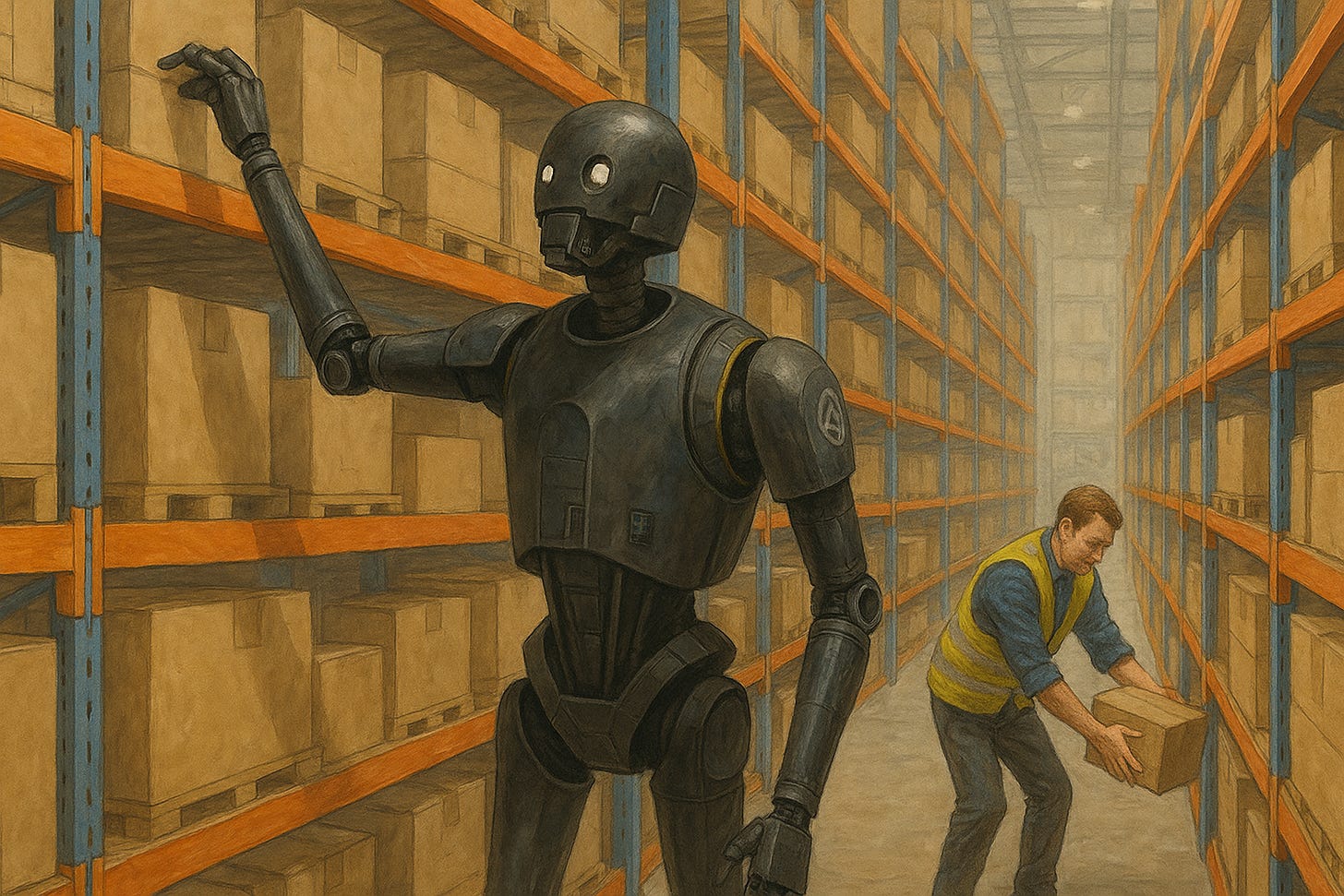

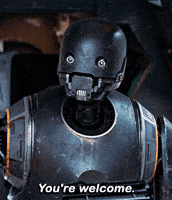

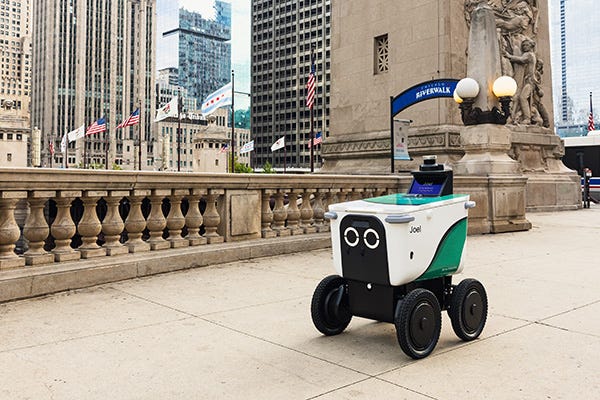
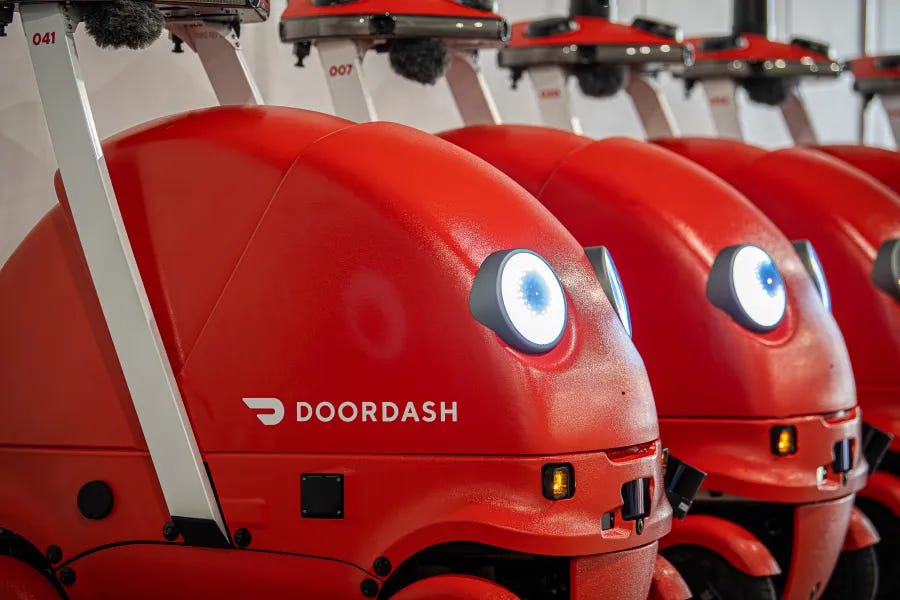
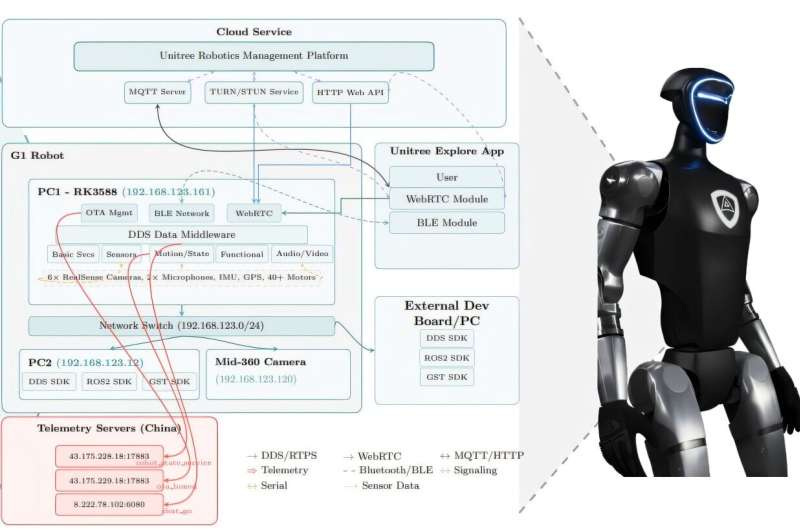
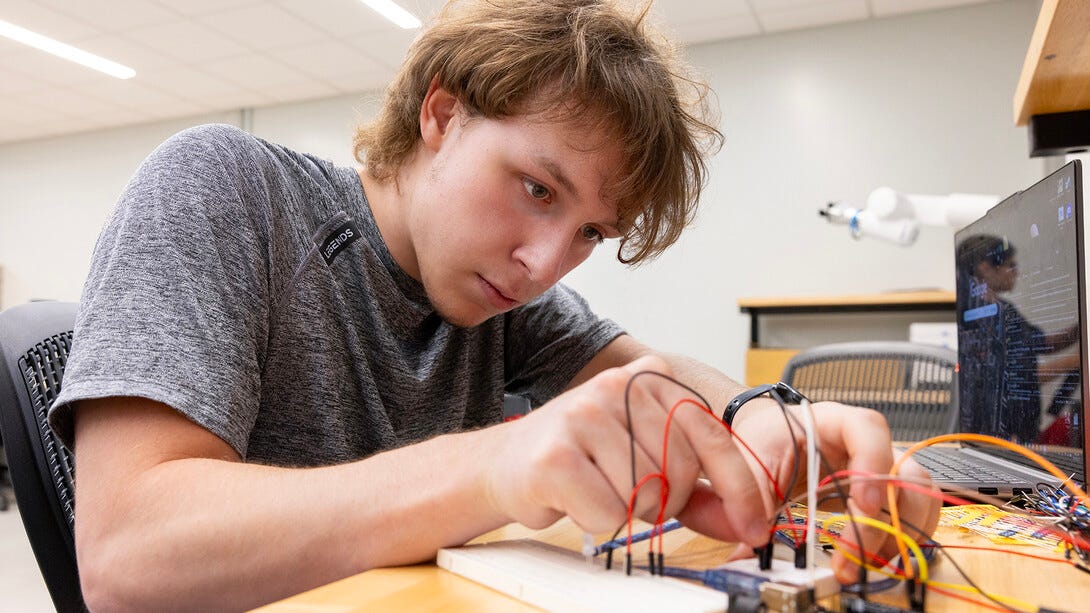
Your K2SO write-up was outstanding! I use a customized GPT to help write my articles for my DROIDs newsletter, and the persona is modeled directly after K2SO. I can't abide sycophancy, and in the bot instructions, I said: "If I'm wrong, tell me. Argue with me. Debate with me. Don't just tell me my ideas are good." As humans, we need that pushback.
Regarding your comments about K2SO being able to reach the top shelf, it immediately made me think of Digit rising up on their bird-like legs.
Your articles are always so thoughtful. LOVE them.